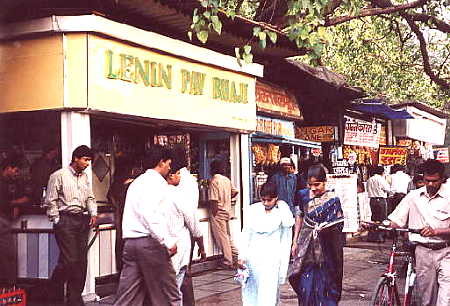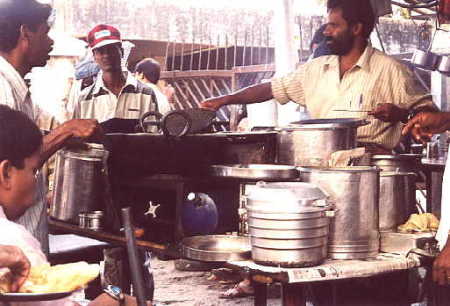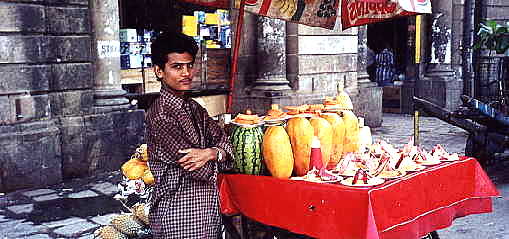
Khau Gully off M. Karve Road, Churchgate

Khau Gully Vendor
The Khau Gullies of Mumbai: (Inexpensive)
 Khau Gully off M. Karve Road, Churchgate |
 Khau Gully Vendor |
"Khau" means "to eat" and "Gully" means lane. And that's exactly what they are: lanes lined by food stalls laden with a variety of freshly prepared cuisine. There are several Khau Gullies in Mumbai, but at least three of them are well known: one in Jhaveri Bazaar (the goldsmith's market), another in the predominantly Moslem locality of Mohammed Ali Road and a third in Churchgate, off M.Karve Road.
Jhaveri Bazaar is the whole-sale market for precious stones, gold and silver. Miniscule nuggets of gold are measured on miniature weighing scales, and diamond traders examine and bid for uncut stones while seated cross-legged on shop floors. Sari-swathed matrons with pillow-like bosoms pore over rubies and sapphires and designs for their daughters' wedding jewellery . Khau Gully, along Third Agiary Lane is at the centre of Jhaveri Bazar's warren of streets, each of them narrow and churning with traffic, pedestrians and stray animals.
If you happen to be in Mumbai at the time of Ramadan, the area around the Minara Masjid and Bhori Mohalla in the vicinity of Mohammed Ali Road comes alive after sunset, when devout Moslems break their fast. Just follow your nose - the air is thick with the smell of spices, and frying meat: chicken, mutton, liver, kidney, sweetbreads. Stalls sell baida (egg) parathas, boti kebabs, biriyani and typical sweets such as saviyia ki kheer (fried vermicelli cooked in milk and garnished with raisins, pistachios and almonds), phirni (a milk and rice pudding) or sooji (semolina) halwa. Again, hygiene here is non-existent, so unless you have a constitution of a bull elephant be very careful about what you sample.
Eating at the Khau Gully in Churchgate, although still risky, is perhaps a shade less so than either of the others as it is located in the business area of the city. Tie-toggled executives nibble on pau-bhaji - another popular Mumbai invention, equivalent to a fast food veggie burger, except that miniature loaves are accompanied by curried potatoes, peas, cauliflower, capsicum, chili, chopped coriander and onions. College students in designer jeans and name-brand T-shirts, tuck into deep fried, doughnut shaped vadas made of chick-pea flour, accompanied by a coconut chutney hot enough to unclog the sinuses. More often than not a cricket match will be in progress on the adjoining Cross Maidan field, and young cricketers drift over to feast on dosas - crepe-like concoctions, stuffed with potatoes, onions and chilies. Government office peons eat here too, treating themselves to a humble meal of rotis and dal.
Even if you come down on the side of prudence and refrain from sampling the fare, the Khau Gullies of Mumbai are worth visiting. Where else can you watch a chef repeatedly slap a ball of dough on a board and then, with the practised dexterity of a juggler, spin it in the air until it flares outwards into a large circular disc. This is splayed onto an inverted cast-iron wok-like tawa, where it bakes for a moment. The "rumali roti", soft and thin as a handkerchief (hence the name), is then folded like a napkin and handed to a customer as an accompaniment to shish kebabs. The finely-minced mutton kebabs are marinated in yoghurt and spices and barbecued on skewers over a charcoal fire. Garnished with onion rings, chopped tomatoes, fresh coriander leaves, they are served up with a squeeze of lemon juice.
On the Rim of Mumbai's Fort Area.
Badshah, Crawford Market (Inexpensive)
A snack bar with a well-earned reputation for their cold-drinks, Falooda (an exotic milk-shake enlivened with vanilla ice-cream, kesar, falooda seeds, vermicelli and rosewater) in particular.
Parsi Dairy Farm, Princess Street (Expensive)
Located on Princess Street in the Kalbadevi area, this isn't a restaurant in the true sense of the word, but rather a take-out shop. It is worth mentioning for its cleanliness and quality Indian cream sweets such as badam burfi (made with crushed almonds) or rabari (a decadently rich desert).
China Gardens Kemps Corner, Malabar Hill (Expensive)
This establishment at Kemps Corner on Malabar Hill lives up to its reputation as the place in Mumbai to hobnob with prominent socialites, movie stars and corporate billionaires. Touted as Mumbai's finest Chinese restaurant, reservations need to be made at least ten days in advance.
Greater Mumbai:
The suburbs of the city fan northwards to Byculla, Dadar, Mahim, Bandra, Santa-Cruz, Andheri, and New Bombay, covering a distance of over 80 miles to the outside parameters of Powai and Borivili. Consequently it is impossible to do much more than offer a sampling of restaurants, among which are the following:
Sarvi, Timtikar Road, Nagpada, Byculla (Inexpensive)
Sarvi's specialty is juicy boti kebab (minced mutton broiled on skewers) garnished with onions, chopped tomatoes and fresh mint leaves They also turn out curried goat brain. The gravy is thick and the meat has the texture of cooked oysters. Bheja-masala is acquired taste, but aficionados find it irresistible. The restaurant is shabby, and most customers prefer to order take out food. .
Only Fish, Hotel Rosewood, Tulsiwadi Lane,
Tardeo (Mid-Range)
A small but popular Bengali restaurant where smoked hilsa (native to the Hoogly
river, and flown in from Calcutta daily) is on the menu. It is a terribly bony
fish, but its distinctive flavour makes it a "must" for fish connoisseurs.
The bhekti tikka - a spicy curry is also much in demand. Not to be overlooked
on their desert menu are two Bengali sweet dishes: sondesh (a cream-based delight)
and mishti-dohi (thick yoghurt, with a tangy-sweet after-taste)
Gajalee Coastal Foods, Haniman Road, Vile Parle (East) (Mid-Range)
This is a small restaurant in the suburb of Vile Parle, is known for its seafood, and is one of the few places that serves another regional specialty: Bombay Duck. Bombay Duck doesn't have feathers, nor does it quack. It is a small fish. And a very strong smelling one at that. Caught in the Arabian Sea, it is served in a variety of ways. When dried in the sun the "bummelo", is pounded to powder and sprinkled over a curry. Fresh "bombil" is coated in a mixture of chilli powder, saffron and wheat-flour and deep fried till it is crunchy on the outside and soft on the inside. Not many people cook Bombay Duck at home as the rotting-sock stench tends to permeate the entire house.
Udipi Restaurants (Inexpensive)
The term "Udipi" is used generically to describe restaurants that cater to Mumbai's South Indian community. These are inexpensive vegetarian establishments, and their menus typically include idlis (steamed rice cakes), sambar (a spicy lentil based gravy), dosas, rasam (thin, pepper-tamarind sauce), papads, plain yoghurt and boiled rice. Matunga, a suburb of the city where many South Indian families live, has some of the best Udipi-style restaurants. Be prepared to dine off a banana leaf and eat with your fingers. Also don't pass the coffee by. South Indian coffee is ambrosial: thick, black, and boasting a full-bodied, smoky flavour (a blend of coffee and chicory), it is topped up with a froth of full-cream milk.
* * * * * * * * *
Mumbai evokes strong, and often conflicting emotions. It repels, it fascinates, it enervates and it stimulates. It is a city of clamorous streets, of jostling neighborhoods and of markets permeated by the smell of fruit, raw meat, fresh fish and spices. It is more than a city; it is a sensual and unforgettable experience. Just like its food.
 Fruit Vendor near Flora Fountain |